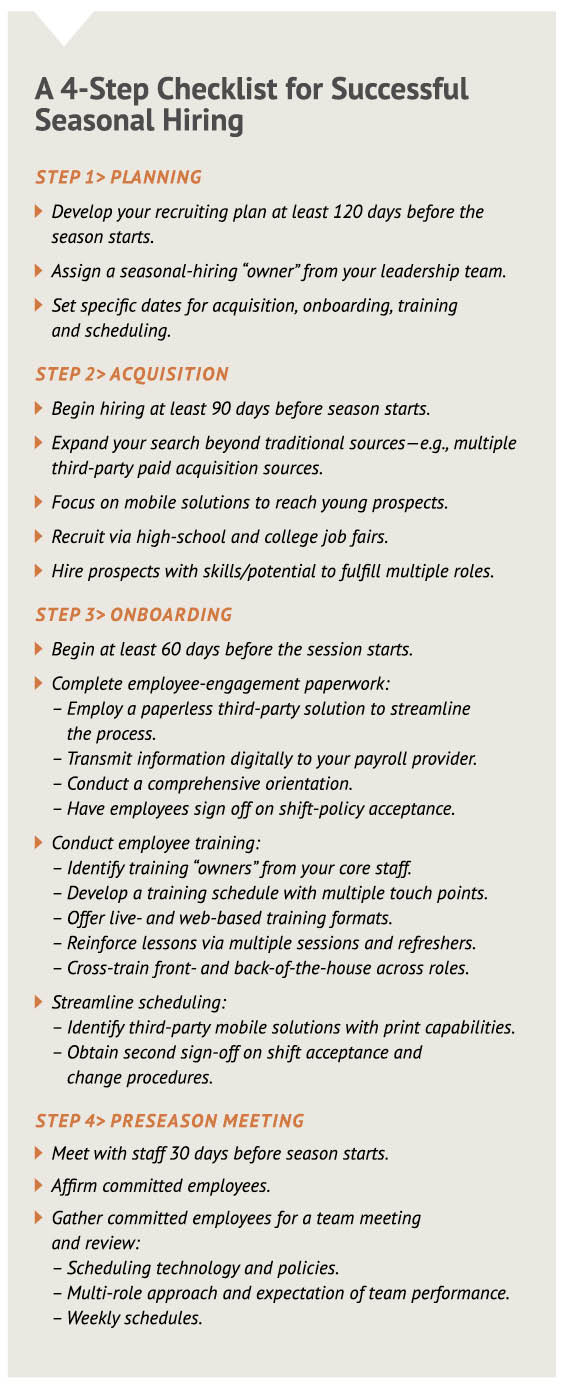Spring brings two of the most popular dining-out holidays—Easter and Mother’s Day—and, along with them, high guest expectations. Hot on the heels of those holidays is summer with guests spending leisure time at restaurants.
With extra business comes an extra challenge: finding additional holiday and/or seasonal help in an already tight labor market. Operators need to get the right people on board at the right time and in the right way. Here’s how.
1. Spring into planning mode
Start early—during the post-Christmas/New Year’s lull. About 120 days. experts say, is a reasonable timeline for creating a comprehensive plan.
“Most operators think, ‘I have to fill a job opening,’” says Florida-based Dan Longton, CEO of TraitSet, a workforce-management service provider. “But what they need is a recruiting strategy. What age group are you going to recruit? Where? How do you reach them?”
Map out specifics, Longton advises, including exact dates for acquisition, onboarding, training and fitting new hires into the schedule. Put your plan in writing and delegate tasks to a manager or supervisor.
Step 2. Acquire new hires
“Putting out help-wanted signs puts you behind the curve,” Longton says. “Use every tool available.”
At least 90 days before the holiday or season for which you need additional workers, initiate these recruitment methods:
College/community-college websites. Most, Longton reports, allow you to post jobs at no charge.
Expand your search. “Truly seasonal workers get recruited from a long distance,” Longton explains. “For example, Myrtle Beach operators recruit in the Poconos. Many foodservice workers summer up north, then go back to Florida for the winter.”
Leverage technology. “Technology gives you the competitive advantage,” Longton says, “but monster.com and careerbuilder.com are outmoded. Over 70 percent of first-time job searches are conducted on indeed.com. Enter the job title, business name and ZIP code. Candidates can apply via smartphone—and that’s definitely what the under-35 age group uses. Speed’s important; respond quickly to younger workers, who are used to instant communication. Contact them immediately after they email you.”
Store interview questions on-site and email them to candidates. Then conduct up to 40 interviews per position via video interviewing: “This excellent tool for hiring people at a distance lets you glean clues about a candidate’s hygiene and precision,” Longton notes.
Utilize social media: Post jobs on your operation’s Facebook page and website. Tweet about seasonal openings.
Work with a third-party recruiter. Resources, such as TraitSet can place, refresh and manage job postings, and ensure that your jobs come first for search-engine recognition.
Hire the right people. Seek versatile prospects. Conduct behavioral assessments to determine good work ethic and integrity.
Get referrals. Ask current employees to refer someone working a similar job elsewhere who could pick up hours.
Develop a call-back roster. Contact past seasonal employees to see if they could fill in this season.
Hire the right number of people. Anticipate your labor needs by reviewing spreadsheets from last year’s Easter, Mother’s Day and summer season, then staff accordingly.
Step 3. Onboarding
The better prepared you and your seasonal workers are, the smoother your operation will run during their tenure.
Dot I’s and cross T’s. Use a third-party provider to lower costs and improve efficiencies for everything from initial paperwork to payroll. (TraitSet’s online OnBoard, for example, handles all the paperwork details and signing in as little as 10 minutes.)
Conduct comprehensive training and orientation. Train holiday and seasonal hires as you do regular staff. Anything less weakens your brand and jeopardizes your business. Teach new hires about your brand, your brand touchpoints, your operation’s culture and how you provide hospitality. Stress the need to make holidays special by thanking guests for spending them with you and invite them to come back.
Offer online and/or video training that holiday and seasonal workers can review immediately. Review your employee manual, policies, procedures and questions with them.
Train in advance. If possible, offer paid training before workers hit the floor.
Cross-train. Prepare hired to fill many roles. Cross-training lets you do more with fewer people
Communicate scheduling protocols. Set seasonal workers’ expectations about policies—e.g., no time off during the holidays, no schedule switching, etc.—ahead of time.
Step 4: Meet with staff
Thirty days before the season starts, confirm your list of hires and conduct a team meeting to review everything—from expectations to policies and procedures to schedules. This last, crucial step keeps everyone on the same page.
“Introduce everybody by name and say something personal about them,” Longton says. “This assimilates new hires and tells other employees these recruits are part of the team.”
Seasonal workers and the law
Seasonal workers, Longton notes, are exempt from the Affordable Care Act’s mandate that operators provide healthcare coverage to employees who work more than 30 hours per week.
A seasonal worker, Longton adds, is defined as one who is employed for a season (six months or a repeatable period of time that begins and ends the same time each year). Have your strategic recruiting plan define definite beginning and end periods for holidays and seasons (Easter weekend, Mother’s Day, spring break, summer, etc.), then schedule seasonal staffers as needed.
The bottom line when it comes to hiring holiday and seasonal help? “It takes effort,” Longton says, “but that’s the way to get a big payback.”
A helpful checklist
Print this checklist out and use it as a guide for seasonal hiring.












